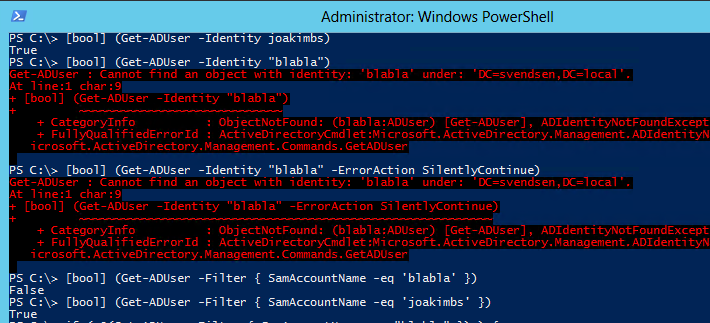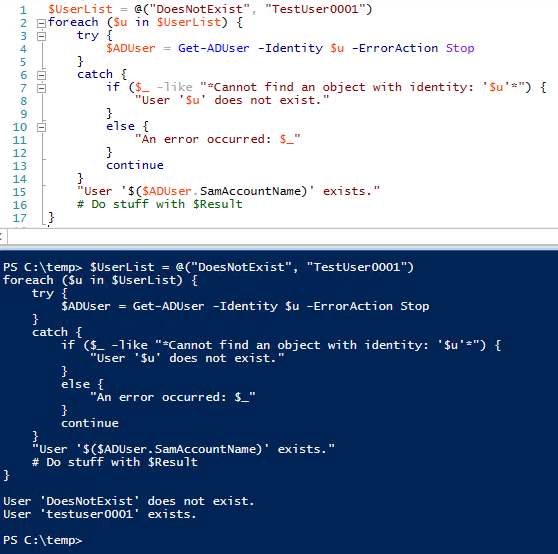Jump to page sections
- Screenshot example
- Verifying an AD user exists - failed attempt one
- Verifying an AD user exists - successful attempt one
- Verifying an AD user exists - successful attempt two
- New behavior
- Verifying an AD user exists using ADSISearcher
In this article, I describe how to check if an Active Directory user exists or not with the PowerShell cmdlet Get-ADUser, and show how to handle the quirks, such as the one that -ErrorAction Stop does not work, nor does setting $ErrorActionPreference = 'Stop', and using try {} catch {}.
The AD cmdlets are inconsistent with PowerShell standards in some ways. Missing -WhatIf support on critical cmdlets, "-Properties" instead of "-Property" (you're supposed to use the singular form; this is seen on other parameters as well here and there) , -ErrorAction doesn't behave as many expect, and possibly things I don't know about, to mention a few.This information is valid as per 2016-01-28, with 2008 R2 and 2012 R2 servers using the built-in Get-ADUser cmdlet. PowerShell versions 2, 3, 4, and 5.
I revisited this problem now on 2017-03-12 and, to my surprise, now the try/catch block works on 2012 R2 on a fresh install against a Server 2016 AD controller. The screenshot below, showing the failures, is from 2012 R2, but against a 2016 AD in the new lab, still on 2012 R2 (fresh install), it works. I'm not sure if the AD cmdlets have somehow been updated (I didn't think that was possible, but can it happen via Windows Update now??) or if it's because the AD controller itself is Server 2016.tl;dr:
[bool] (Get-ADUser -Filter { SamAccountName -eq $SomeSamAccountName })
Screenshot example
It also demonstrates one of the successful verification methods I document more extensively below in this article.

Verifying an AD user exists - failed attempt one
Import-Module ActiveDirectory
$SamAccountName = 'doesNotExist'
try {
$User = Get-ADUser -Filter { SamAccountName -eq $SamAccountName } -ErrorAction Stop
}
catch {
Write-Warning -Message "User does not exist."
}
Except it does not print the warning. Setting $ErrorActionPreference = 'Stop' does not work either. This is a bug/flaw with at least this AD cmdlet. I suppose the reason would be that it doesn't fail to execute the query, it just doesn't find the user.
These tests were performed on a 2012 R2 computer with PSv5 in January 2016. Now that it's March 2017, also see the new behavior.Verifying an AD user exists - successful attempt one
if (@(Get-ADUser -Filter { SamAccountName -eq $SamAccountName }).Count -eq 0) {
Write-Warning -Message "User $SamAccountName does not exist."
}
This works.
Verifying an AD user exists - successful attempt two
You can also simply cast what's returned to a [bool] type; that's a so-called boolean value that can either be true or false (respectively traditionally represented by the numbers 1 and 0).
$SamAccountName = 'doesnotexist'
[bool] (Get-ADUser -Filter { SamAccountName -eq $SamAccountName }) # returns false
$SamAccountName = 'joakimbs'
[bool] (Get-ADUser -Filter { SamAccountName -eq $SamAccountName }) # returns true
So you can check in an if statement (I also tossed in a foreach loop) like you see below. Remove the "-not" to invert the logic and check if a user exists.
foreach ($SamAccountName in 'doesNotExist', 'joakimbs') {
if (-not [bool] (Get-ADUser -Filter { SamAccountName -eq $SamAccountName })) {
Write-Warning -Message "User ${SamAccountName} does not exist."
}
}
Another example (PSv3 on Server 2008 R2):
PS C:\> $users = 'joakimbs', "blabla"
PS C:\> $users | foreach { [bool] (Get-ADUser -Filter { SamAccountName -eq $_ } ) }
True
False
New behavior
Image example of how you can now do it:

As text:
PS C:\temp> $UserList = @("DoesNotExist", "TestUser0001")
foreach ($u in $UserList) {
try {
$ADUser = Get-ADUser -Identity $u -ErrorAction Stop
}
catch {
if ($_ -like "*Cannot find an object with identity: '$u'*") {
"User '$u' does not exist."
}
else {
"An error occurred: $_"
}
continue
}
"User '$($ADUser.SamAccountName)' exists."
# Do stuff with $ADUser
}
User 'DoesNotExist' does not exist.
User 'testuser0001' exists.
PS C:\temp>
Verifying an AD user exists using ADSISearcher
I base my example on what I found here on Microsoft Technet about ADSI/LDAP and have amended a few things based on the query to target only users that I looked up in my own wiki article here (about getting usernames from Active Directory).
First I tried what Richard Mueller mentions, and did this:PS D:\> $SamAccountName = 'test'PS D:\> $Searcher = [adsisearcher] "(sAMAccountName=$SamAccountName)"
PS D:\> if (@($Searcher.FindOne()).Count -eq 1) { "$SamAccountName exists" } else { "$SamAccountName does not exist" } test exists PS D:\> get-aduser test get-aduser : Cannot find an object with identity: 'test' under: 'DC=ad,DC=example,DC=org'.
So "test" is found as a SAM account name, but is not an actual AD user object (another type of object, see below). Since the SAM account name is unique per AD, I suppose the distinction is not always needed between a user or other type of object, but if it is, here's how to verify it really is a '''user''':
# I was wondering what kind of object "test" is.
PS D:\> (Get-ADObject -Filter { SamAccountName -eq 'test' }).ObjectClass
group
PS D:\> $SamAccountName = "test"
PS D:\> $Searcher = [adsisearcher] "(&(objectCategory=Person)(objectClass=User)(sAMAccountName=$SamAccountName))"
PS D:\> if (@($Searcher.FindOne()).Count -eq 1) { "$SamAccountName exists" } else { "$SamAccountName does not exist" }
test does not exist
The only difference is in the LDAP query, where I added "(objectClass=user)", which targets users, and "(objectCategory=Person)", which filters out "contact" type AD objects that would otherwise be part of the results. You can use other LDAP queries that might be better than what I've been using.
Powershell Windows ADBlog articles in alphabetical order
A
- A Look at the KLP AksjeNorden Index Mutual Fund
- A primitive hex version of the seq gnu utility, written in perl
- Accessing the Bing Search API v5 using PowerShell
- Accessing the Google Custom Search API using PowerShell
- Active directory password expiration notification
- Aksje-, fonds- og ETF-utbytterapportgenerator for Nordnet-transaksjonslogg
- Ascii art characters powershell script
- Automatically delete old IIS logs with PowerShell
C
- Calculate and enumerate subnets with PSipcalc
- Calculate the trend for financial products based on close rates
- Check for open TCP ports using PowerShell
- Check if an AD user exists with Get-ADUser
- Check when servers were last patched with Windows Update via COM or WSUS
- Compiling or packaging an executable from perl code on windows
- Convert between Windows and Unix epoch with Python and Perl
- Convert file encoding using linux and iconv
- Convert from most encodings to utf8 with powershell
- ConvertTo-Json for PowerShell version 2
- Create cryptographically secure and pseudorandom data with PowerShell
- Crypto is here - and it is not going away
- Crypto logo analysis ftw
D
G
- Get rid of Psychology in the Stock Markets
- Get Folder Size with PowerShell, Blazingly Fast
- Get Linux disk space report in PowerShell
- Get-Weather cmdlet for PowerShell, using the OpenWeatherMap API
- Get-wmiobject wrapper
- Getting computer information using powershell
- Getting computer models in a domain using Powershell
- Getting computer names from AD using Powershell
- Getting usernames from active directory with powershell
- Gnu seq on steroids with hex support and descending ranges
- Gullpriser hos Gullbanken mot spotprisen til gull
H
- Have PowerShell trigger an action when CPU or memory usage reaches certain values
- Historical view of the SnP 500 Index since 1927, when corona is rampant in mid-March 2020
- How Many Bitcoins (BTC) Are Lost
- How many people own 1 full BTC
- How to check perl module version
- How to list all AD computer object properties
- Hva det innebærer at særkravet for lån til sekundærbolig bortfaller
I
L
M
P
- Parse openssl certificate date output into .NET DateTime objects
- Parse PsLoggedOn.exe Output with PowerShell
- Parse schtasks.exe Output with PowerShell
- Perl on windows
- Port scan subnets with PSnmap for PowerShell
- PowerShell Relative Strength Index (RSI) Calculator
- PowerShell .NET regex to validate IPv6 address (RFC-compliant)
- PowerShell benchmarking module built around Measure-Command
- Powershell change the wmi timeout value
- PowerShell check if file exists
- Powershell check if folder exists
- PowerShell Cmdlet for Splitting an Array
- PowerShell Executables File System Locations
- PowerShell foreach loops and ForEach-Object
- PowerShell Get-MountPointData Cmdlet
- PowerShell Java Auto-Update Script
- Powershell multi-line comments
- Powershell prompt for password convert securestring to plain text
- Powershell psexec wrapper
- PowerShell regex to accurately match IPv4 address (0-255 only)
- Powershell regular expressions
- Powershell split operator
- Powershell vs perl at text processing
- PS2CMD - embed PowerShell code in a batch file
R
- Recursively Remove Empty Folders, using PowerShell
- Remote control mom via PowerShell and TeamViewer
- Remove empty elements from an array in PowerShell
- Remove first or last n characters from a string in PowerShell
- Rename unix utility - windows port
- Renaming files using PowerShell
- Running perl one-liners and scripts from powershell
S
- Sammenlign gullpriser og sølvpriser hos norske forhandlere av edelmetall
- Self-contained batch file with perl code
- Silver - The Underrated Investment
- Simple Morningstar Fund Report Script
- Sølv - den undervurderte investeringen
- Sort a list of computers by domain first and then name, using PowerShell
- Sort strings with numbers more humanely in PowerShell
- Sorting in ascending and descending order simultaneously in PowerShell
- Spar en slant med en optimalisert kredittkortportefølje
- Spre finansiell risiko på en skattesmart måte med flere Aksjesparekontoer
- SSH from PowerShell using the SSH.NET library
- SSH-Sessions Add-on with SCP SFTP Support
- Static Mutual Fund Portfolio the Last 2 Years Up 43 Percent
- STOXR - Currency Conversion Software - Open Exchange Rates API
